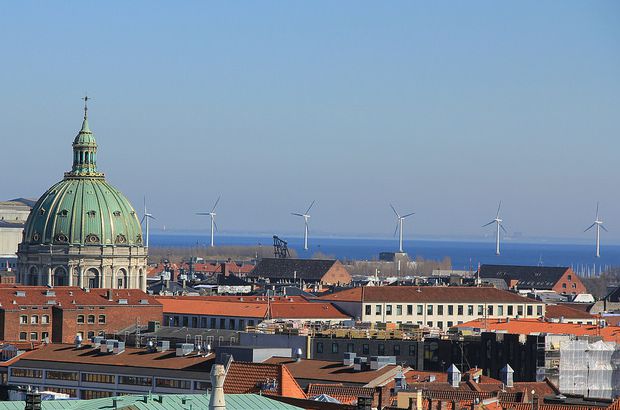
This article is part of The Road through Paris, a series leading up to the COP21 international climate talks in December. It is also the second in an eight-week blog series from New Energy Cities detailing the state of the low-carbon city movement.
Ten years ago, when Seattle Mayor Greg Nickels launched the U.S. Mayors’ Climate Protection Agreement, local governments were just awakening to the threat of climate change. Over 1,000 local elected officials ultimately committed to meet or beat the Kyoto Protocol’s greenhouse gas emissions reduction target of 7% below 1990 levels by 2012.
Since then, leading urban governments have set more aggressive goals, with many now committing to carbon neutrality or 80% reduction by 2050 (80x50), and others committing to source 100% of their energy with renewables by specific target dates. These are not empty pledges, but achievable goals that local officials are already implementing.
In March 2015, the Urban Sustainability Directors Network launched the Carbon Neutral Cities Alliance, comprised of 16 cities that had adopted carbon neutrality targets. Seattle, Copenhagen, and Fort Collins, CO are among the leading examples of communities that have mapped out how to achieve ambitious goals:
- In May 2011, Seattle (pop. 652,000) commissioned an analysis from Stockholm Environment Institute of what it would take for the city to achieve carbon neutrality by 2050, and adopted a climate plan with proposed actions that add up to this goal. Because Seattle gets virtually carbon-neutral electricity from its municipal utility, its primary carbon liabilities are fossil gas use for heating in buildings and oil consumption in transportation.
- Copenhagen, Denmark (pop. 562,000) set a goal of becoming carbon neutral by 2025, which would make it the first carbon neutral capital in the world. To achieve this, the city has determined that: all district heating and cooling must be carbon neutral by 2025; commercial buildings must reduce energy consumption by 20%, households by 10%, and public buildings by 40%; all of the city’s electricity consumption must come from renewable sources (including in-city wind turbines); and city residents must rely on bicycling, walking, or public transportation for 75% of trips.
- In March 2015, the bipartisan Fort Collins, Colo. (pop. 152,000) city council adopted a new goal of 80% carbon reduction by 2030, accelerating its original timeline by 20 years. This revised goal emerged from a conversation that the city facilitated among community leaders and experts, including municipally-run Fort Collins Utilities, local businesses, Colorado State University, and environmental advocates, with analysis and support from Rocky Mountain Institute’s eLab initiative. Specific sector-based targets include: reducing building emissions by 40% through efficiency and rooftop solar; reducing utility emissions 79%; and reducing transportation carbon emissions 57%.
In the past year, an increasing number of communities have also committed to using 100% renewable energy. Numerous entities worldwide have embraced this target—as highlighted in the efforts of Global 100% RE, Go 100% (which maintains a summary of entities that set targets and how they are planning to achieve them), and Renewables 100 initiatives, as well as a World Future Council handbook.
Aspen, Colo. (pop. 6,700), Greensburg, Kan. (pop. 785), and Burlington, Vt. (pop. 42,000) have already met that goal. In 2004, Aspen adopted a 100% renewable electricity goal as part of its Canary Initiative climate agenda, and sought advice from the U.S. Department of Energy’s National Renewable Energy Laboratory on how to get there. It achieved the goal in August 2015 with the approval of new power purchase contracts for wind and landfill gas.
In 2007, after a tornado devastated the small farming town of Greensburg, Kan., a community organization mobilized the town to rebuild green, relying on deep efficiency in buildings (many exceeding 50% savings) and a local 12.5 MW wind farm. In 2014, Burlington, Vt., achieved 100% carbon-neutral electricity, using wind, biomass, and hydropower—including a 7.4-MW hydropower project near the city.
San Francisco, Calif., and Georgetown, Texas, are also working to become fully renewable:
- In 2010, San Francisco Mayor Gavin Newsom set a goal for the city (pop. 837,000) to use 100% renewable energy within 10 years, and in 2011 Mayor Ed Lee convened an in-depth taskforce to recommend how to get there. In 2012, the task force recommended that the city: improve energy efficiency to reduce total electric demand; increase in-city renewable distributed generation to reduce the need for imported green power; and provide all customers with a 100% renewable power purchasing option.
- In 2014, the municipal utility of Georgetown, Texas (pop. 55,000) committed to buy half of its community’s power from a nearby wind farm, and in 2015 signed up for the remaining half to come from a West Texas solar farm, making its electricity supply 100% renewable. As a result, Georgetown (pop. 55,000) will become the first city in Texas to go completely renewable. According to the utility’s general manager, “Georgetown isn’t required to buy solar or other renewables. We did so because it will save on electricity costs and decrease our water usage.”
These aggressive goals are not without challenges. Seattle will face a tough road on reducing fossil gas use in buildings and oil in transportation. Environmentalists have criticized Copenhagen’s plan for relying heavily on biomass, which has potentially negative social and environmental effects. Burlington is sourcing much of its energy from large-scale dams in Canada that have drawn the ire of social and environmental activists.
But as urban climate plans have evolved, so have public reporting and accountability, as well as understanding of the most effective ways to achieve ambitious goals. In 2015, 162 cities worldwide voluntarily reported to the Carbon Disclosure Project (CDP) on their sources of electricity, and CDP is using its findings to help influence future urban infrastructure investments. Registries such as CDP and carbonn Climate Registry and pledges such as the Compact of Mayors, which now spans six continents, are leading the way to greater transparency and learning. Meanwhile, the Carbon Neutral Cities Alliance is funding groups of peer cities worldwide to learn together how to overcome their biggest barriers, including transitioning off of fossil gas for heating.
A decade after the urban climate movement began, local leaders and their partners are implementing ambitious carbon reduction strategies. The road to becoming a low-carbon city is not easy, but Greensburg, Georgetown, and other leading cities are showing the way.





